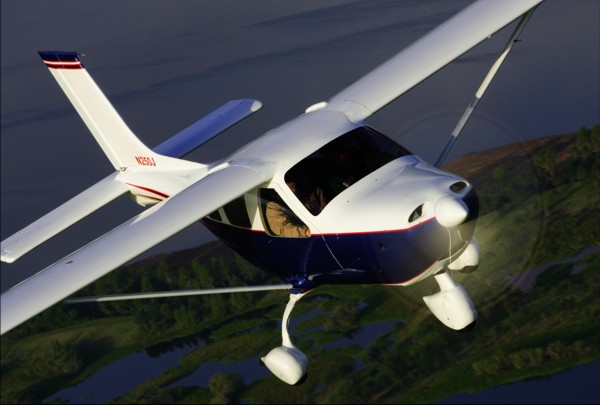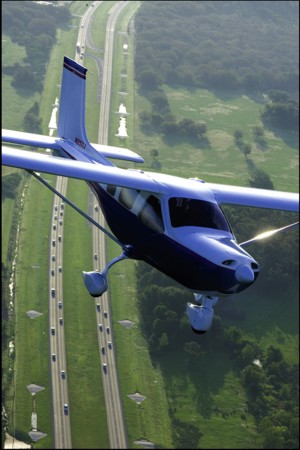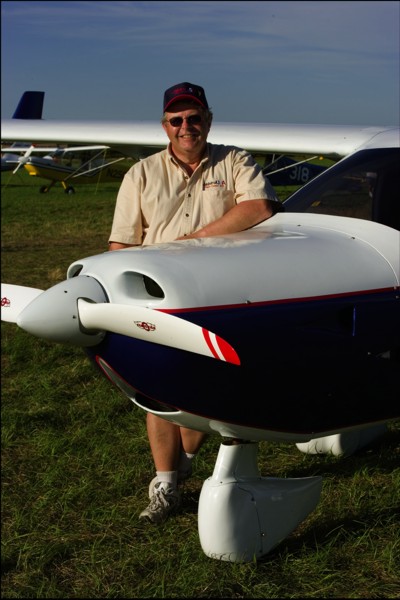

Imagine leaving the rush of groundbound
traffic behind and commuting
to work in the J250. No doubt some
pilots will find such uses for their new
light-sport aircraft.

With a nearly all-glass cockpit, the
Jabiru J250 can hold its head high in
the company of any modern aircraft.

Jabiru Australia manufactures not only
this airframe but also its powerplant,
the six-cylinder Jabiru 3300, which
produces 120 hp.

With three wide doors, entering and
exiting the aircraft and accessing
the large cargo compartment is
convenient.

Buyers can choose from a variety
of interior appointments, including
leather seats, if so desired. Pilot and
copilot share a center-mounted stick.
At 43-inches wide and with an instrument
panel shaped to allow more knee
room, the J250’s cockpit should be
comfortable for pilots of most any size.

The Jabiru J250 uses the same airframe
as the company’s four-place
aircraft, the J400. However, the LSA
version is fitted with only two seats,
leaving the back seat open for cargo.
Throw your golf clubs or skis in the
back, and in a few hours you can be
recreating wherever you desire!

Pete Krotje (shown here) and his son,
Ben, are the principals of Jabiru USA,
importing both the Jabiru aircraft and
engines from Australia.
What’s that airplane with the funny sounding name?
The question arises when pilots, unfamiliar with the new
brands introduced by the light-sport aircraft (LSA) category, try
to comprehend the name Jabiru.
“And this airplane company also makes its own engine?”
This second question frequently follows the first. Jabiru USA’s
Peter “Pete” Krotje and his staff must tire of the explanation.
“It’s JAB-i-roo,” I heard Pete reply patiently one day at EAA
AirVenture Oshkosh 2005. “And, yes, the company makes both
the airframe and engine.”
So begins the tale of this new airplane from the country down
under famous for kangaroos and cowboys who speak English
in a distinctly different way. Designed by Jabiru Australia of
Bundaberg West, Australia, the J250 and J170 recently earned
special light-sport aircraft (S-LSA) certification, which the
Calypso hopes to do soon as well.
It’s A Little Big Plane
As you walk up to the
J250, this modern, composite cruiser
looks like a small airplane, yet entering
the J250 is easy and, once inside, the
cockpit is surprisingly roomy, especially
given its enormous luggage area.
Jabiru uses the same fuselage for its
two-place J250 as it does for its fourplace
J400, which definitely gives the
J250 the largest baggage area of any
LSA on the market.
“This airplane is designed to exceed
the expectations of pilots stepping
down from Cessna 172s, Skylanes, or
Bonanzas as the most desirable, up-todate
personal aircraft,” Jabiru’s salesmen
claim. Once these pilots get past
the size of the J250, that statement
might be true.
This Australian airplane comes to
Yankee customers differently than LSA
imported from European countries.
Unlike those aircraft, Jabiru USA is the
manufacturer of record. It buys components
from Jabiru Australia, assembles
them, and does all the fiberglass
work and bonding.
The parts Jabiru USA
receives are ready for
an American assembly
line. “In Australia, all
aircraft components
are made the same, no
matter whether they’re
going on a certificated
airplane bound for
one country or in a
kit for another,” Pete
advised.
Effectively, then,
this is a U.S.-manufactured
aircraft. “But, it’s
not the same as RANS,
which makes most of
its own components,”
Pete explained. Like
Boeing or General
Motors, which use
parts made in other
countries, the finished
products are
considered
American manufactured. The
phrase coined more
than a decade ago, is “domestic content,”
relating to how much of the final
product is created here in the U.S.
Jabiru Australia prefers not to fully
build aircraft for the U.S. market, as
it doesn’t believe it can do the continuous
safety monitoring specified by
the ASTM standards. And, like most
non-U.S. producers, they are fearful
of America’s legendary litigiousness.
Besides, shipping fully built airplanes
from distant Australia would present
other challenges.
Jabiru USA, then, must do all
the continuous safety monitoring,
and it must audit Jabiru
Australia as a supplier to its
U.S.-based production. They
do so by looking at the audit
of the down-under business
by its Civilian Aviation Safety
Authority (CASA), Australia’s equivalent
to the FAA.
The J250 I was privileged to fly was,
therefore, a U.S.-built airplane based on
an Australian design and airframe components.
But many items are supplied
from non-Australian sources.
Examining N250J
The doors open wide on all Jabiru
airplanes I’ve flown, easing the effort to
get inside. And because they’re all high
wings, you don’t have to scramble atop
the low wing first. Many folks find high
wings easier to enter. However, Jabiru’s
doors are rather difficult to open and
close properly. New doors are being
developed, and that’s something buyers
will want to examine in the future.
A second door on the pilot’s side
allows easy access to Jabiru’s voluminous
baggage area. The space is so
large, the main concern will be to not
overload it. However, no straps were
provided to secure items placed in
this area.
Upon entering the cockpit I noticed
the little big plane was nicely equipped
with avionics, with an EFIS system and
an electronic engine information monitoring
system (EIS). It had an all-glass
cockpit with no conventional steam
gauges. The bright, color-screened
Grand Rapids Technology Horizon I
EFIS was fed its GPS information from
a Lowrance AirMap 100, though the
latter instrument was somewhat awkwardly
mounted on the left side of the
panel above the left-side throttle. A
throttle is available on either outside
edge of the cockpit with a single joystick
in the middle.
Firing up Jabiru engines has always
been a simple experience for me. I’ve flown the engines in several other aircraft
makes and models. Most general
aviation pilots like the engine, as
it sounds closer to their experience and
because the tachometer readings seem
more normal compared to the much
higher-revving Rotax 912 series.
We taxied out from our Sun ‘n Fun
parking spot with the usual trip around
the airfield to get to the end of the runway.
This allowed time to experiment
with the ground handling.
The rudder steering on the ground
is a direct linkage, Nick Otterback, my
Jabiru salesman/copilot explained, and
that accounted for me having to do
all the work. For me, taxiing the J250
was not a comfortable experience. The
pedal movements took extra effort, and
the control was not particularly responsive.
Without directional braking, I felt
it might be difficult to make tight turns
on airport ramps.
Ground steering challenges and illfitting
doors notwithstanding, I was
anxious to get this plane airborne, and
flying the Jabiru J250 turned out to be a
pleasant experience.
Once we got the wave-off, I fed in
power and the big six-cylinder Jabiru
3300 engine pulled us smartly forward.
It was the beginning of an interesting
and impressive flight behind
the big Aussie engine. Rotation came
quickly at 40 mph, and we were off.
We immediately headed to South
Lakeland Airpark, a grass strip conveniently located just three miles from
the Sun ‘n Fun grounds. Its 4,000-foot
runway is a great place to practice
takeoffs and landings, especially in airplanes
you’ve never flown previously.
If anything, I had a little trouble
keeping the J250’s speed down sufficiently.
On landing approach, the
procedures are: add a notch of flaps at
90 mph and drop to 80 mph on base
leg; then you can add up to full flaps.
Full flaps are needed for landing the
J250. It preserves energy quite well, so
you can fly your final approach at 70
mph and could slow down to 60 mph
or less on short final, at least once you
are familiar with the airplane.
My problem was that I allowed the
speed to creep up, except for my fourth
and last landing, which was great.
I also felt like I might run out of
elevator range as I pulled the stick
way aft, though I never did.
Short field operations would
take some practice. Maintaining the
right speeds is essential; if you do
so, short field operations are achievable.
But as a superb cross-country
flyer, J250 can cruise right at the
maximum 120-knot LSA limit and is
comfortable in that environment.
Ease of Handling
Describing the J250’s ease of handling
might best be done by relating
a story from a photo shoot with EAA’s
photo plane; it says volumes about the
J250’s flight characteristics.
When Ben Krotje and Nick were
flying the J250, EAA’s photographer
told them to assume a 30-degree bank
and just orbit; the photo plane would
fly around them and shoot the desired
views. A few minutes into this exercise,
the two J250 pilots received another
message: “Would you please put your
hands on the joystick so it looks like
you’re actually flying.”
My own experience performing
steep turns in the J250 suggests it will
consistently hold bank with almost
no input, assuming you first have
trimmed it well. It exhibits straightforward
handling characteristics, and this
evaluation applies at max speeds or in
slow flight.
My steep turn trials, done at 45 to 50 degrees of bank for 720 degrees of turn,
proved the J250 carves beautiful turns.
I held altitude precisely with little input
needed.
I found the rudder would stick a
little, requiring modest input to return
the pedal to neutral. The J250 in which
I flew was the first kit Jabiru USA assembled
as an LSA and had not earned SLSA
certification at the time I evaluated
it. In approved S-LSA, the controls will
have return springs to help re-center
these controls.
Next I wanted to check how well
the Australian-designed engine and airplane
would perform together. I felt
it would be interesting to see how an
integrated engine/aircraft would perform.
I wasn’t disappointed. This is
one of the fastest LSA in the group. It
will easily reach the maximum allowed
(120 knots/138 mph) under the new
regulations.
The J250’s best climb rate is 90 mph,
which produces an indicated 1,200
fpm. This was measured at lower altitudes
on a hot, humid day in central
Florida. Slow flight was comfortable at
53-54 mph showing on the EFIS system,
and maximum speeds ran well past the
120-knot/138-mph limit for LSA when
the big Jabiru was left at 3150 rpm for a
brief full-power evaluation.
At maximum continuous power, the
LSA criterion for speed, with power set
at 2750 rpm, the J250 ran right at the
maximum cruise of 120 knots. The
Grand Rapids Technology Horizon I
EFIS has a true airspeed box that we
used for this determination.
In the J250’s newly revised Operations
Manual, maximum continuous power
(Vh) is capped at 2850 rpm, Pete said.
(Vh is the engine manufacturer’s official
statement of maximum continuous
power.) He reports that this power
setting produces 120 knots of cruise if
you are lightly loaded or 118 knots at
full gross. Originally, the Vh power setting
was 2750 rpm, but Jabiru Australia
recently raised this figure to 2850.
With the additional 100 rpm, Jabiru
USA had to clip two inches off the prop,
switching to a 49-inch from a 51-inch
diameter. Yet thanks to improved carburetion,
Pete said the Jabiru engines
are flying at the higher power setting
and using the same or less fuel. He said
the 100-rpm bump raised the J250’s
climb rate while still keeping the speedy
model within the LSA definition.
And, yes, you can run the engine at
the higher rpm for extended periods
of time, Pete added, but above 2850
the engine starts to use more fuel, plus
you are exceeding the manufacturer’s
recommendation.
The economic controls are effective.
Even 50 rpm more will burn as
much as a gallon an hour more, and
most pilots won’t want to both bust
the manufacturer’s suggestion and pay
that much more in fuel cost. However,
if you do choose to pour fuel down the
drain (and fly as a recreational pilot or
higher), the Jabiru can run close to its
Vne of 138 knots (159 mph).
At its top speed, I found the J250 to
be smooth and controllable. It was an
experience that suggests cross-country
flying in the J250 should be enjoyable
and speedy|and also relatively free of
surprises. All of Jabiru’s aircraft have successfully
completed the FAA’s FAR Part 23 testing requirements, including a full
spin matrix, complete static, dynamic,
asymmetrical loadings, and load drop
testing, Jabiru USA advertises.
Another reliable indicator of a design
is time in the field, and Jabiru claims
300 J250s are flying around the world.
A Jabiru for You?
The J250 blazes the LSA trail for
Jabiru USA. It’s also the price leader
at $87,900. If you want the vacuum
panel upgrade to the standard panel,
add $4,600 for artificial horizon and
directional gyro plus a transponder. An
EFIS option in the form of the Grand
Rapids Technology Horizon I plus GPS
and transponder will run $8,600. A
cloth interior with leather seats adds
$650 or a more deluxe leather interior
with leather seats adds $2,000. Go the
deluxe route on everything, and you
can hike your tab to almost $100,000.
But for all its attributes, J250 is only
one of three LSA choices Jabiru USA
offers buyers. You can also choose from
the new J170 or the proven Calypso.
All will meet the definitions of the LSA
regulation.
The J170, expected on the market
shortly after you read this, will use the
Jabiru 2200 engine and be configured
as a trainer. It sells for $74,900, a whopping
$13,000 savings over the J250.
Though, of course, the J250 uses the
3300 engine with the larger four-seater
fuselage while the J170 uses the twoseat
fuselage.
The roomy and powerful J250 may
not be your pick or fit in your budget. If
you don’t need the model’s huge interior
volume or the six-cylinder 3300
engine, the company has still another
choice that will also save you cash.
Jabiru USA plans to sell its popular kitbuilt
Calypso as a ready-to-fly S-LSA
for only $58,000. At that price with
the 2200 engine and visual flight rules
(VFR) instruments, Calypso represents
quite a bargain for an all-composite
airplane.
So with the top-of-the-line J250 for
$88,000, the J170 that may be useful
for schools seeking a durable trainer for
$75,000, or the Calypso for $58,000,
Jabiru USA has a wide range of aircraft
to offer. And all are essentially made
in the USA. All three models are also
available as kits in the experimental
amateur-built category, offering another
lower-cost option.
Check out these aircraft on a Sport
Pilot Tour or fly-in near you, and see
what this interesting trio of aircraft has
to offer.
| Seating | two, side-by-side, 44 inches |
| Empty weight | 780 pounds |
| Gross weight | 1,320 pounds |
| Wingspan | 30 feet |
| Wing area | 120 square feet |
| Wing loading | 11 pounds/square foot |
| Useful Load | 540 pounds |
| Length | 21 feet, 5 inches |
| Payload (with full fuel) | 324 pounds |
| Height | 7 feet, 10 inches |
| Fuel Capacity | 36 gallons |
| Baggage area | enormous 1 |
| Airworthiness | Certified SLSA |
| Notes: | 1 The J250 is based on the four-seat Jabiru J400 fuselage with no rear seats installed. |
| Standard engine | 120 hp, Jabiru 3300 |
| Power loading | 11 pounds/hp |
| Max Speed | 120 knots |
| Cruise speed | 120 knots |
| Stall Speed | 45 knots |
| Never exceed speed | 138 knots |
| Rate of climb at gross | 700 fpm 1 |
| Takeoff distance at gross | 700 feet 1 |
| Landing distance at gross | 640 feet |
| Range (powered) | 840 nautical miles / 7.2 hours (w/o reserve) |
| Fuel Consumption | 5.0 gph |
| Notes: | 1 Solo performance attributes are 1,200 fpm climb and a 325-foot takeoff roll. |


I flew one of these coast-to-coast as a ferry pilot and can say they are a stable, comfortable platform. I did 20.6 hours in 2 days. It’s a sweet little plane. Cockpit room compared to the GlaStar: baggage was much larger than the GlaStar or 152.
I read the article about Jabiru J250 SP. I strongly disagree with the premise that pilots stepping down from Skyhawk, Skylane or Bonanza would be impressed with the Jabiru size of interior. I have flown all of them and the Jabiru is much smaller in the rudder area, I simply could not fit inside the airplane to safely fly it! Seat and shoulder area was fine, but no joy in rudder area.
Ronald, how tall are you? I was considering it but am 6’5” with size 14 shoes. Your comment gave me pause!
Well, paws are probably what you need, not those size 14 slabs you call feet 😉